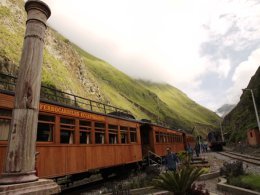Escorted Tours Including Ecuador |
||
Independent Packages Including Ecuador |
||

Escorted Tours Including Ecuador |
||
Independent Packages Including Ecuador |
||

Ecuador
Situated on the equator, Ecuador is the smallest country in the Andean Highlands. Despite its size it is probably the world's most bio-diverse country, crammed with an astounding variety of wildlife, birds and vegetation existing in the contrasts of climatic zones. Within a short time the traveller can experience dramatic changes in scenery, temperature and altitude, journeying between Pacific coast beaches and the sweltering, mosquito-ridden rainforest; to the charming capital city of Quito surrounded by ice-covered volcanoes; and to colourful highland markets that add character and warmth to the windswept highlands of the Andes Mountains. The people, their cultures and traditions have also been formed, and are influenced by, their geographical environment. The backbone of the country is the Andean highlands, made up of two mountainous chains and over 30 volcanoes. Between them lies the central highland valley or sierra, the Avenue of the Volcanoes, at about 8,960ft (2,800m) above sea level. This is the heartland of agricultural activity, punctuated by dozens of remote communities, and is where the bulk of the population live. Larger towns like Saquisilí and Otavalo swell on market days when villagers come to sell their produce and handiwork in a vibrant and colourful atmosphere of festivity. The sierra is also home to most of the old and historically important cities, including Quito. With its beautiful colonial architecture, magnificent panoramic scenery, vibrant indigenous groups and welcoming people it is one of the most enticing and rewarding countries to visit in South America. And, as if it needed anything further, one of the world's greatest treasures of natural history lies in the bewitching Galapagos Islands, famed for its fearless and unique wildlife, and is the highlight of most trips to Ecuador. |
|||||||